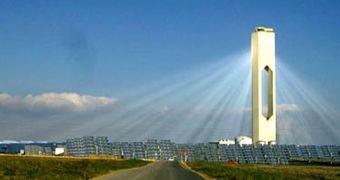Shortly after the Department of Interior in the United States announced that the country was to add 1.1GW to its clean energy capacity, power companies Abengoa and BrightSource Energy made it public news that they were to team up in order to build the world's largest solar tower.
Information shared with the public thus far says that the solar tower is to be built in southern California, in Riverside County, and that construction activities are set to debut until the end of 2013.
By the looks of it, BrightSource is the company in charge of design and solar field technology. On the other hand, BrightSource Energy is to deal with construction, engineering and procurement-related issues.
Due to the fact that the solar tower is supposed to be built on federal land, the country's Bureau of Land Management was asked to facilitate the implementation of this project. According to Inhabitat, it agreed to offer its support.
For those unaware, such solar towers rely on the sun’s energy to produce Steam, and later on use this steam to make electricity.
Because of their only harvesting such environmentally friendly energy sources, solar towers have a rather reduced ecological footprint.
Thus, it is being said that, throughout its entire life cycle, the solar tower set to be built in southern California will keep roughly 17 million tons of CO2 from hitting the natural world.
Throughout the construction phase, the solar tower will also lend a helping hand to the country's economy. This is because its being built is expected to translate into 2,000 new job opportunities being created.
Once up and running, the solar power is set to generate enough electricity to power a total of 200,000 households, the same source informs us.
As Interior Secretary Ken Salazar argued this past week, “These renewable energy projects reflect the Obama Administration's commitment to expand domestic energy production on our public lands and diversify our nation's energy portfolio.”

 14 DAY TRIAL //
14 DAY TRIAL //